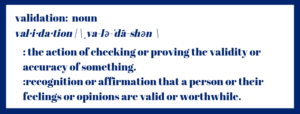Validation is the simple but alarmingly difficulty task of observing, acknowledging, and accepting another person’s point of view.
To validate and accept their point of view doesn’t mean that you necessarily agree with what they are saying. It means that you are hearing them and attempting to understand where they are coming from. It means you approach their statement non-judgmentally.
Validation is a skill that can build relationships, create bridges between people, and foster a sense of love and acceptance. It means that you are willing to listen long enough to hear what the other person is saying and that you are willing to try to understand what they mean.
What Validation Isn’t:
Problem-solving is the antithesis of validation.
When someone tells us something that is challenging them and we respond with solutions, we are probably missing the point. This isn’t to say that problem solving isn’t useful. If I’m carrying all the groceries in the house you better believe that I’m looking for more than just acknowledgment of how heavy the items are. I’m definitely looking for my husband to get up and get the rest of the bags. But it’s nice when he says something about how strong I am and how much I can carry. If you are going to attempt to problem-solve for someone else, be sure you validate them first.
Validation is not trying to convince another person that they shouldn’t feel a certain way.
Instead of telling someone to “cheer up, everything happens for a reason”, try saying “that seems like a really hard situation, do you want to talk about it?” Cajoling or guilting someone out of feeling a certain way leaves them feeling more disconnected. Avoid the one-up-manship of statements like “you think that’s bad, I have it so much worse”. Try to see it from their point of view and validate that what they are going through is tough.
Validating Little Kids
Validation is can be an especially useful tactic with children. Recently, my daughter was convinced that the pre-bedtime snuggle time was unfair; she believed that her brother was getting more time. The injustice of this was distressing and she insisted on an equal distribution of snuggle time. I could have used logic, reasoning, and facts to try to convince her that she was wrong and the snuggle-time was exactly the same. This would have probably resorted in a back-and-forth conversation that would probably have left us both very frustrated. Another way that I could have handled this situation would be to tell her she was wrong, shut her down and end the conversation right there and then. There is a third way, the validation way, to handle this type of situation.

In order to validate my daughter in this situation, I had to:
- really hear what she was saying and what she meant by what she was saying.
- be interested, engaged and focused on her
- search for the kernel of truth in what she was telling me.
Then, I truly heard what she was saying to me, which was that she wanted more of my time than what she had received.
After I was able to hear what she was telling me through her complaints, I was able to validate how she was feeling. I could tell her, “I can hear that you miss me and wish that we could spend more time together, and I miss you too.”
Validating Teenagers
Validation is one of the most powerful tactics when dealing with adolescents. Adolescents can be mercurial, moody and hard to reach at times. When they finally divulge their thoughts and feelings, you better be ready to receive them. If you’re not, it may be a while before they express themselves to you again.
For example, if your teenager talks to you about feeling left out:
- Hold off on offering explanations and solutions:
- Acknowledge that it must feel pretty awful for her to see all her friends hanging out without her.
- Ask questions like “what does that feel like?” or “can you tell me more about that?”
- If you’re brave, share a personal experience but only if it serves to help her feel better, not worse.
- Something like, “I wonder if you’re feeling left out after seeing they went to the mall without out you. I remember feeling that way, but it might be worse now since you have to watch it all over Snapchat.”
- Be real. Adolescents are super-sleuths when it comes to authenticity. You can’t fake validation.
- Avoid sarcasm and don’t assume you know what they are feeling or thinking.
- Assume that their feelings are valid. Thoughts are more likely to be faulty, however.
- Tread lightly, but you could try, “I know it feels like you have no friends, but are there any other versions of that story that might be true?”
Validating Adults
When our kids were small, like most kids, they didn’t sleep particularly well. Paired with some of my own insomnia, I was barely scraping together a few hours of sleep at night. After a few months, I was sort of at my breaking point. I was grouchy, sleep deprived and snapping at the people I love most. My mental health was suffering. At night, I would lay awake, seething with resentment while my husband lay next to me snoring away.
So one day, when he said he was “so tired” I totally lost it on him. I launched into a diatribe about how tired I was, and how dare he compare his level of tired to my level of tired. Full disclosure, I did this in a restaurant in downtown Portsmouth, after two glasses of wine, less than 4 hours of sleep, and in front of a crowd. It was ugly. I did not choose the validation path. Instead of admitting that I don’t hold the title of “Most Tired Ever” I tried to prove exactly how wrong he was. Not my finest moment.
If I had validated him, it might have sounded something like this:
“I get it. It’s so hard to be as tired as we are. I’m tired too. I’m having a hard time functioning.”
Because I didn’t accept his truth of how tired he was at that moment, he couldn’t connect with my truth either. We both felt misunderstood and resentful. If I had validated him, I would have heard him, acknowledged his truth and realized that he was probably not trying to win the competition of who is more tired. Instead of being in it together, my lack of validation created barriers to understanding and mutual suffering. I wanted to be understood and acknowledged, but because I didn’t offer that to him, I couldn’t receive it either.











